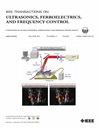利用交叉光谱矩阵拟合进行被动空化成像的反演方法。
IF 3
2区 工程技术
Q1 ACOUSTICS
IEEE transactions on ultrasonics, ferroelectrics, and frequency control
Pub Date : 2024-06-19
DOI:10.1109/TUFFC.2024.3416813
引用次数: 0
摘要
高强度聚焦超声(HIFU)会产生空化现象,需要对其进行监测,以用于声波修复、靶向给药或组织切削等特定应用。文献中已经提出了被动声学绘图作为监测空化的方法,但由于缺乏时间参考,这种方法缺乏空间分辨率,主要是在轴向。与标准脉冲回波超声相比,这是被动成像的一个常见问题。为了提高轴向分辨率,我们提出了一种适用于被动空化成像的跨谱矩阵拟合(CMF)方法,该方法以解决反问题为基础,并采用不同的正则化处理,以提高重建空化图的稀疏性:弹性网(CMF-ElNet)和稀疏总变异(CMF-spTV)。我们展示了模拟和实验数据的结果,并将其与最先进的方法进行了比较,如频率延迟和(DAS)和频率鲁棒卡蓬波束成形器(RCB)。我们展示了该方法在提高轴向分辨率方面的优势,与 RCB 和 DAS 相比,轴向半宽最大值(FWHM)分别降低了 3 和 5。此外,与 RCB 相比,基于 CMF 的方法在实验条件下可将对比度与噪声比 (CNR) 提高 15 dB 以上。我们还展示了在处理云形空化源时,稀疏总变异先验比弹性网更有优势,因为云形空化源可以假定为稀疏分组源。本文章由计算机程序翻译,如有差异,请以英文原文为准。
An Inverse Method Using Cross-Spectral Matrix Fitting for Passive Cavitation Imaging
High-intensity focused ultrasound (HIFU) can produce cavitation, which requires monitoring for specific applications such as sonoporation, targeted drug delivery, or histotripsy. Passive acoustic mapping has been proposed in the literature as a method for monitoring cavitation, but it lacks spatial resolution, primarily in the axial direction, due to the absence of a time reference. This is a common issue with passive imaging compared to standard pulse-echo ultrasound. In order to improve the axial resolution, we propose an adaptation of the cross spectral matrix fitting (CMF) method for passive cavitation imaging, which is based on the resolution of an inverse problem with different regularizations that promote sparsity in the reconstructed cavitation maps: Elastic Net (CMF-ElNet) and sparse Total Variation (CMF-spTV). The results from both simulated and experimental data are presented and compared to state-of-the-art approaches, such as the frequential delay-and-sum (DAS) and the frequential robust capon beamformer (RCB). We show the interest of the method for improving the axial resolution, with an axial full width half maximum (FWHM) divided by 3 and 5 compared to RCB and DAS, respectively. Moreover, CMF-based methods improve contrast-to-noise ratio (CNR) by more than 15 dB in experimental conditions compared to RCB. We also show the advantage of the sparse Total Variation (spTV) prior over Elastic Net (ElNet) when dealing with cloud-shaped cavitation sources, that can be assumed as sparse grouped sources.
求助全文
通过发布文献求助,成功后即可免费获取论文全文。
去求助
来源期刊
CiteScore
7.70
自引率
16.70%
发文量
583
审稿时长
4.5 months
期刊介绍:
IEEE Transactions on Ultrasonics, Ferroelectrics and Frequency Control includes the theory, technology, materials, and applications relating to: (1) the generation, transmission, and detection of ultrasonic waves and related phenomena; (2) medical ultrasound, including hyperthermia, bioeffects, tissue characterization and imaging; (3) ferroelectric, piezoelectric, and piezomagnetic materials, including crystals, polycrystalline solids, films, polymers, and composites; (4) frequency control, timing and time distribution, including crystal oscillators and other means of classical frequency control, and atomic, molecular and laser frequency control standards. Areas of interest range from fundamental studies to the design and/or applications of devices and systems.

 求助内容:
求助内容: 应助结果提醒方式:
应助结果提醒方式:


